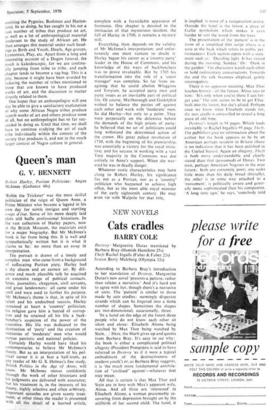Black arts
J. B. DONNE
The Arts of Africa Rene S. Wassing (Thames and Hudson 210s)
The problem of the European confronted with African art is not a problem of aesthetics, but the problem of what is meant by art in a non-literate society. Oriental art can be studied through the vast corpus of written evidence, of treatises on art, of religi- ous texts that discuss iconography, of annals and histories, of artists' notes on their tech- niques and their biographies and autobio- graphies, and of archaeological evidence. But the tribes south of the Sahara, even those who produced the masterpieces in bronze of He and Benin and the finest wood- carvings of the savannah lands in the southern Congo—the Kuba, Lunda, Luba and their neighbours—have left no docu- mentation as to their purpose, intention or significance, for they had no means of doing so. Oral traditions exist in many cases, but these tend to be aetiological myths and seldom show concern with art objects.
African archaeology is still in its infancy, and though it has made some remarkable discoveries—such as the Sao civilisation south of Lake Chad and the Nok civilisation on the Bauchi plateau of Central Nigeria— it has raised new problems rather than solved old ones. Where, therefore, historical evi- dence is almost entirely lacking, the under- standing of African art relies very heavily on the findings of the anthropologist. We hope that through his study of political
systems, social organisation, religious beliefs. the so-called secret societies, and other cul- tural phenomena which differ so radically from our own, light may be thrown on the background to those examples of African art which we have learnt to accept and appreciate on aesthetic grounds.
This is clearly the intention of Dr Rene S. Wassing, an anthropologist who has carried out fieldwork in West and Central Africa and is Curator of the Museum of Geography and Ethnology in Rotterdam. 'I have taken as a starting point,' he says in his Foreword. 'the close relationship between the art oi Black Africa and the culture from which it arose.' Here, at last, one hopes is a book that will place African art in its cultural set- ting and social context.
There are 264 illustrations in colour and black and white, and the temptation is to look through these first. Most of the photo- graphs are by Hans Hinz, and those in black and white in particular are good. Most of the objects shown have been chosen from lesser-known collections, which is a refresh. ing change. This naturally means that there are few masterpieces, and some tribes get a poor showing, but generally speaking the artistic level is high.
However, there are exceptions. Does Dr Wassing really consider that the pomade box made of tortoise shell, leather and glass beads from the Herero of South-West Africa (PI. 3) is a work of art? Unfortunately, there is no reference to it in the text. And what is this colour photograph of a Masai warrior's hair-style doing in an art book? In the text, three columns are devoted to the institution of age-groups among the Masai, ending with the remark, 'In this COIL' nection the Masai really produced very little worthy of the name of art'.
But the opposite situation can arise. In the catalogue at the end of the book half a dozen Pende amulet masks from the Congo are illustrated. These little ivory masks, usually about two and a half inches high, are de- lightful to the touch and have often been beautifully stained through their long con- tact with the human body. But the para- graph in the text referring to these and other collectors' items, such as the miniature masks of the Dan, ends: 'The collector of African art generally takes little interest in all these things connected with magic, be- cause they are usually unattractive, if not actually ugly and repellent, and are better suited to purely ethnographical collection, than the art collector's cabinet.'
Dr Wassing has become the victim of A topological problem. It is well known that the art-producing tribes of Africa are con- centrated in West Africa and the Congo area. Outside these two regions traditional art rapidly gives way to craftwork. But West Africa and the Congo area do not make an anthropological unit, since the Congo tribes are related to the other Bantu-speaking peoples of east and southern Africa, and moreover many of the art-producing tribes of the Congo have not been subject to inten- sive anthropological study. So Dr Wassing has decided to take as his field all the people of Black Africa, meaning the Sudanic Negro and all the Bantu-speaking peoples (but omitting the Pygmies, Bushmen and Hotten- tots). In so doing, he has caught in his net a vast number of tribes that produce no art, as well as a lot of anthropological material irrelevant to the study of African art. He then arranges this material under such head- ings as Birth and Youth, Death, Age-groups, Economics, Play, etc. Apart-from a long and interesting account of a Dogon funeral, the result is kaleidoscopic, for we are continu- ally jumping from tribe to tribe, and each chapter tends to become a rag-bag. This is a pity, because it might have been avoided by reducing the number of tribes mentioned to those that are known to have produced works of art, and the discussion to matter directly related to them.
One hopes that an anthropologist will one day be able to give a satisfactory explanation of why some African Negro tribes produce superb works of art and others produce none at all, but no anthropologist has so far suc- ceeded in doing so. Until that time, we shall have to continue studying the art of each tribe individually within the context of the society that produces it, and not in the much larger context of Negro culture in general.































 Previous page
Previous page